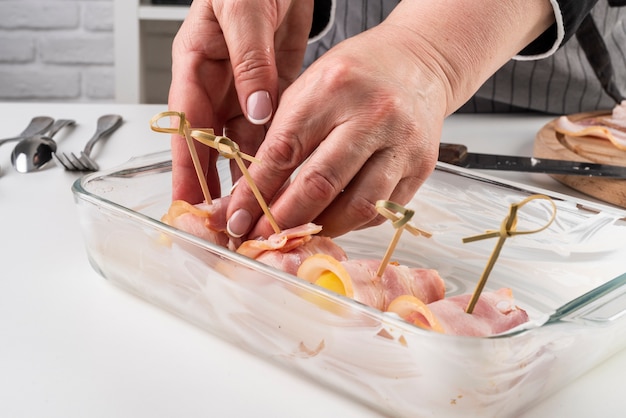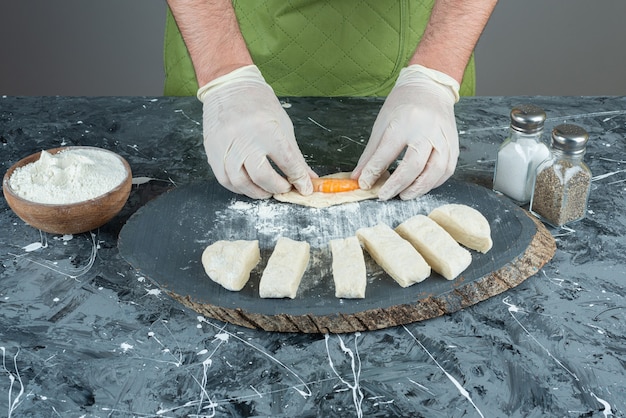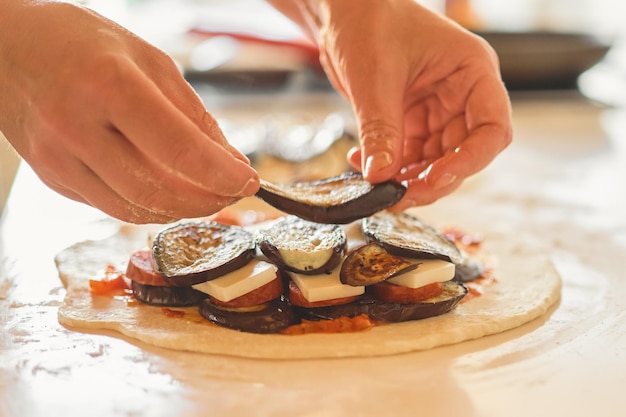There's a certain je ne sais quoi about a perfectly seared scallop, a symphony of textures and flavors that makes my taste buds sing. The golden-brown crust, crisp and yielding, gives way to a tender, succulent interior, bursting with the delicate sweetness of the sea. It’s a culinary experience that never fails to impress, and one that I’ve spent countless evenings perfecting in my kitchen.
This isn’t just any scallop recipe; it’s a journey, a meticulous exploration of technique and flavor that will elevate your cooking game. From selecting the freshest scallops to mastering the art of searing, we’ll cover every detail, ensuring your kitchen becomes a haven for culinary brilliance. Get ready to impress your friends, family, or simply yourself with scallops that melt in your mouth and leave you wanting more.
(Part 1) Choosing the Right Scallops: A Matter of Taste

The journey to perfect scallops starts long before the pan hits the heat. It starts with the selection, a process that requires a discerning palate and an eye for quality. You can’t expect a masterpiece without the right ingredients, and when it comes to scallops, the difference between good and great is a matter of taste – literally.
Freshness: The Essence of Flavor
The first rule of scallops is: freshness reigns supreme. Avoid scallops that have a strong fishy odor or a slimy texture, both signs of poor quality. Instead, seek out scallops that boast a slightly sweet, briny aroma, indicative of their ocean-fresh origins. They should also feel firm and plump to the touch, a testament to their freshness and quality.
bay scallops vs. sea scallops: A Matter of Preference
The world of scallops is divided into two main camps: bay scallops and sea scallops. Each has its own distinct personality and appeal, appealing to different tastes and culinary preferences.
- Bay Scallops: These petite treasures are known for their delicate sweetness and tender texture. They're often smaller in size, lending themselves to a more delicate approach in the kitchen. Their intense flavor and higher price tag make them a true delicacy.
- Sea Scallops: Larger and meatier, sea scallops offer a more substantial bite and a firmer texture. They're typically more budget-friendly than their bay scallop counterparts and hold up well to grilling, pan-frying, or even roasting.
Ultimately, the choice between bay scallops and sea scallops comes down to personal preference. Some prefer the delicate sweetness of bay scallops, while others crave the hearty texture of sea scallops. Experiment with both to discover your favorite.
Size Matters: Achieving Consistent Cooking
When shopping for scallops, don't be shy about asking your fishmonger about their size. Aim for scallops that are roughly the same size for a more even cook and a visually pleasing presentation. Smaller scallops will cook faster than larger ones, so keeping them uniform helps ensure everyone enjoys their scallops at their peak of perfection.
(Part 2) Prepping the Scallops: A Stage for Flavor

You’ve chosen your scallops, now it’s time to prepare them for their starring role in your culinary masterpiece. These steps, while simple, are crucial in ensuring your scallops achieve their full potential.
Pat Dry: A Dry Surface for a Crisp Crust
Before you begin cooking, pat the scallops dry with paper towels. This is a vital step that many overlook, but it makes all the difference in achieving that beautiful, golden-brown crust. Excess moisture will lead to steaming rather than searing, hindering the development of the crisp exterior we desire.
Muscle Removal: A Farewell to Chewy Bites
You’ll often find a small, tough muscle attached to the side of each scallop. This muscle can be chewy and unpleasant to eat, so it's best to remove it before cooking. Use a sharp knife to gently pry it away from the scallop, ensuring a smooth, tender texture in every bite.
Seasoning and Marinades: A Symphony of Flavor
With the scallops prepped and ready, it’s time to introduce flavor! Keep it simple with a sprinkle of salt and freshly ground black pepper, allowing the natural sweetness of the scallop to shine through. For those who enjoy a touch of complexity, a simple marinade can elevate the experience. Mix lemon juice, olive oil, and your favorite herbs for a bright and vibrant flavor profile. Remember, the goal is to enhance the scallop’s flavor, not overwhelm it.
(Part 3) mastering the searing Technique: The Art of Heat

Now comes the moment of truth: the searing process, the transformative stage where the scallop’s journey culminates in culinary perfection. This is where heat control and technique become paramount.
The Power of High Heat: A Sizzling Transformation
Get your pan screaming hot! We’re talking high heat, the kind that makes the pan sizzle and the air crackle with anticipation. A cast iron pan is ideal for this task, but any heavy-bottomed pan will do. The goal is to create a super-hot surface that will sear the scallops quickly and evenly, creating that coveted golden-brown crust.
Oil Wisdom: A Lubricant for Flavor
Add a generous amount of high-heat oil to your hot pan. avocado oil or grapeseed oil are excellent choices, capable of withstanding high temperatures without smoking. Let the oil heat up completely before adding the scallops. And remember, don’t overcrowd the pan! Cook the scallops in batches if necessary to ensure they have ample space to sear properly, resulting in an even, golden-brown crust.
The Flip: A Dance of Timing
As the scallops sizzle and begin to brown, it's time to flip them over. Use tongs to gently flip each scallop, avoiding unnecessary movement that can disrupt the sear. Cook the second side for a shorter time than the first, as the scallops will cook through more quickly on the second side.
The doneness test: Avoiding Overcooked Disasters
While tempting to cook those scallops to oblivion, overcooking can lead to tough, rubbery, and unappetizing results. Scallops cook incredibly fast, so keep a close eye on them. When they are golden brown on both sides and the centre just turns opaque, they are done. Remove them from the pan immediately and allow them to rest before serving.
(Part 4) Serving Your Scallop Masterpiece: A Showcase of Flavor
You’ve conquered the searing process, now it’s time to showcase your culinary triumph. Serving your perfectly seared scallops is an art form in itself, a chance to create a visually appealing and flavor-packed presentation.
Simplicity Reigns Supreme: Letting the Scallops Shine
The beauty of perfectly seared scallops lies in their pure, unadulterated flavor. A simple plate is often the best way to let them shine. Place a few scallops on a plate, drizzle with a bit of melted butter or a light dressing, and a squeeze of fresh lemon juice for a touch of brightness. This minimalist approach allows the scallop’s natural flavors to take center stage.
Sides for Complexity: Enhancing the Flavor Palette
For those who prefer a more complex culinary journey, consider pairing your scallops with complementary sides that enhance the overall flavor profile. A few options to consider:
- A bed of creamy polenta or risotto provides a rich and comforting backdrop for the delicate scallops.
- A vibrant salad with fresh herbs and citrus adds a touch of brightness and freshness to the dish, complementing the scallops' delicate sweetness.
- A drizzle of balsamic glaze provides a sweet and tangy counterpoint to the scallops, adding depth and complexity to the flavor profile.
- Roasted vegetables offer a colorful and flavorful accompaniment, with the roasted flavors complementing the scallops' delicate sweetness.
Wine Pairing: A Symphony of Taste
No scallop dinner is complete without a perfect wine pairing. A crisp Sauvignon Blanc or a delicate Pinot Grigio will complement the scallops' delicate sweetness, creating a harmonious symphony of flavors.
(Part 5) Tips and Tricks: Mastering the Scallop Art
Over the years, I’ve learned a few tricks of the trade that have helped me achieve consistently delicious results. These tips and tricks will elevate your scallop game and ensure culinary success every time.
Thermometer Wisdom: Ensuring Perfect Doneness
If you're unsure about doneness, use a meat thermometer to check the internal temperature of your scallops. They should reach an internal temperature of 135°F (57°C) for optimal tenderness. This ensures the scallops are cooked through without becoming tough or rubbery.
Resting: Allowing Flavors to Bloom
Give your scallops a few minutes to rest before serving. This allows the juices to redistribute, resulting in a more tender and flavorful dish. It's a simple step that makes a big difference in the overall quality of your scallops.
Flavor Exploration: A World of Possibilities
Don't be afraid to experiment with different seasonings and marinades. Citrus zest, herbs, garlic, and spices can add incredible depth of flavor to your scallops. From a simple sprinkle of herbs to a more complex marinade, the possibilities are endless.
Completing the Meal: A Scallop Symphony
While scallops can be enjoyed as a simple appetizer, they can also be the star of a complete meal. Serve them with a side of pasta, rice, or roasted vegetables for a satisfying and delicious dinner.
(Part 6) FAQs: Your Scallop Questions Answered
Have some lingering questions about scallops? I’ve got you covered! Here are some frequently asked questions and answers to help you become a scallop pro.
1. How do I store scallops?
Store scallops in the refrigerator for up to 2 days, wrapped tightly in plastic wrap or placed in an airtight container. Avoid freezing scallops unless you plan on using them for a recipe that requires frozen scallops.
2. What happens if I overcook scallops?
Overcooked scallops will be tough and rubbery. They lose their delicate texture and become dry. It's crucial to watch them carefully and remove them from the pan as soon as they're cooked.
3. Can I cook scallops in a microwave?
While you can technically cook scallops in a microwave, it's not recommended. Microwaving scallops won't achieve that beautiful sear and will likely result in rubbery, overcooked scallops.
4. Can I use frozen scallops?
You can use frozen scallops, but they may require a slightly different cooking time. Make sure to thaw them completely in the refrigerator before cooking. You may also want to pat them dry more thoroughly to remove any excess moisture.
5. What are some other ways to cook scallops?
Scallops can be cooked in a variety of ways, each yielding unique textures and flavor profiles. Consider these options:
- Grilled: Marinate the scallops in a flavorful dressing and grill them over medium heat for a smoky and chargrilled flavor.
- Baked: Top scallops with breadcrumbs, herbs, and lemon juice and bake them in a preheated oven for a crispy and flavorful result.
- Broiled: Broil scallops for a quick and easy method of cooking, achieving a golden-brown crust and tender interior.
- Pan-fried: This is the most common method of cooking scallops, but you can also try pan-searing them in a skillet with butter, herbs, and garlic for a rich and flavorful experience.
(Part 7) A Scallop Love Story: The Journey of a Foodie
My journey with scallops began with a single, life-altering bite. I remember the first time I tasted a perfectly seared scallop—it was a revelation, a culinary awakening. That delicate sweetness, that melt-in-your-mouth texture, the way it danced on my tongue... it was pure culinary magic.
From that moment, I was hooked. I embarked on a journey of culinary exploration, driven by a desire to understand the nuances of this delicate ingredient and unlock its full potential. I sought guidance from chefs, devoured countless articles and cookbooks, and spent hours watching cooking videos. But the true lessons came from countless evenings spent in my own kitchen, experimenting, tinkering, and perfecting my approach.
I’ve learned that cooking scallops isn’t just about following a recipe; it’s about understanding the ingredient’s delicate nature, respecting its unique properties, and embracing the creative process of transforming it into something truly special. It's about appreciating the art of simplicity, letting the flavors speak for themselves, and creating an unforgettable culinary experience.
(Part 8) Sharing the Joy of Scallops: A Culinary Invitation
This isn’t just a recipe; it’s an invitation. An invitation to experience the joy of perfectly seared scallops, to embrace the magic of simple ingredients, and to create something truly delicious.
So, the next time you find yourself at the fishmonger, pick up a few scallops, take a deep breath, and embark on this culinary adventure. Embrace the challenge, hone your skills, and let the journey of cooking scallops lead you to a world of flavor and satisfaction.
Everyone is watching

Corn on the Cob: The Ultimate Guide to Perfectly Cooked Ears
Healthy MealsAh, corn on the cob. Just the name evokes images of sunny days, barbecues, and that sweet, juicy flavour that ...

Scallops: The Ultimate Guide to Perfect Cooking
Healthy MealsAh, scallops. Those delicate, sweet, and utterly delicious morsels of the sea. They hold a special place in my...

Spaghetti Squash: The Ultimate Guide to Cooking and Serving
Healthy MealsRemember that time you saw spaghetti squash at the supermarket, looking all bumpy and strange, and thought, "W...

Salmon Cooking Times: Perfect Guide for Every Recipe
Healthy MealsLet me tell you, cooking salmon is an art form. It's all about getting that perfect balance: juicy and tender,...

Ham Cooking Time: How Long to Bake, Smoke, or Boil a Delicious Ham
Healthy MealsAh, ham. It's a classic, isn't it? A real crowd-pleaser, especially around holidays. And when done right, it'...
